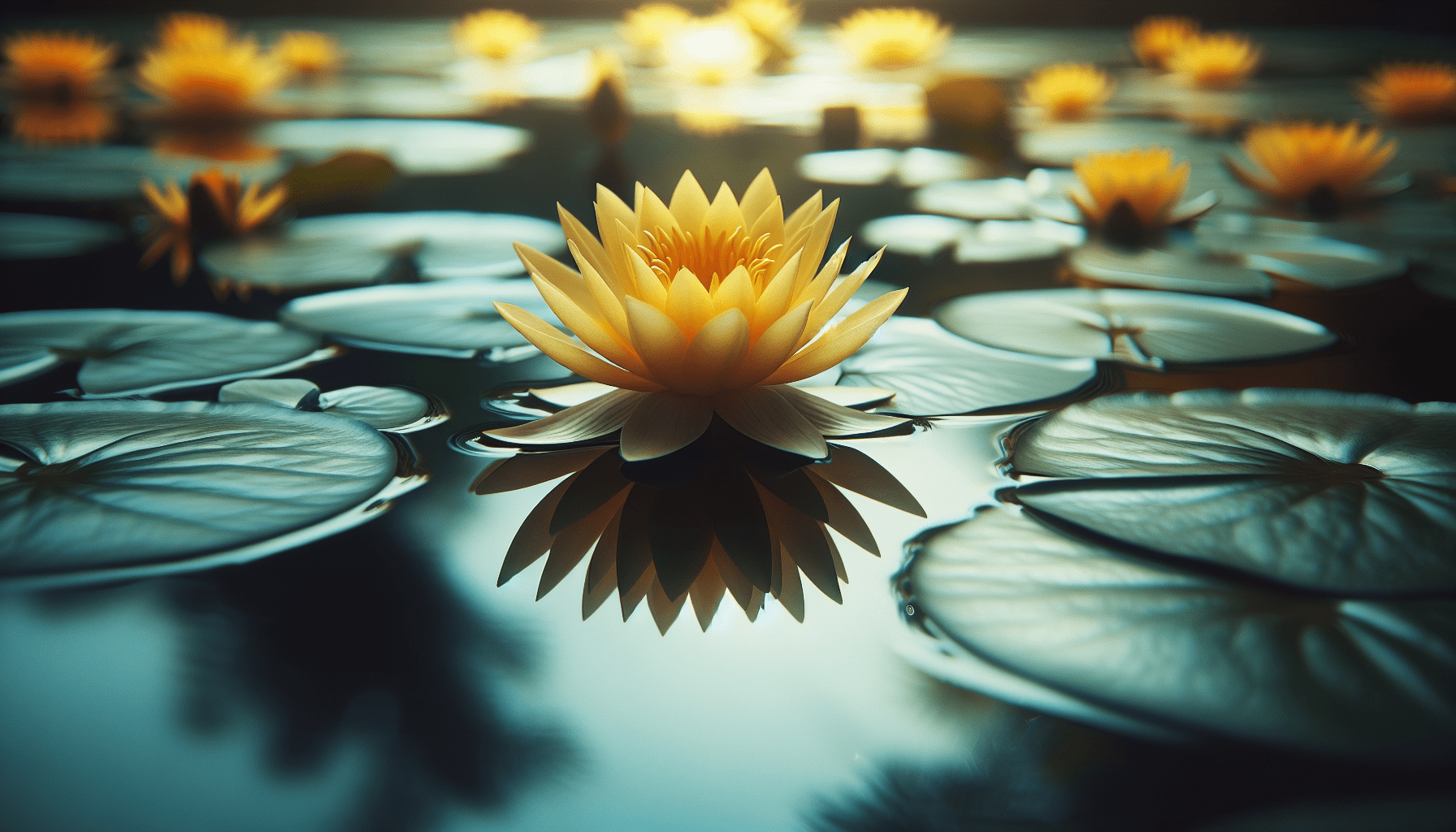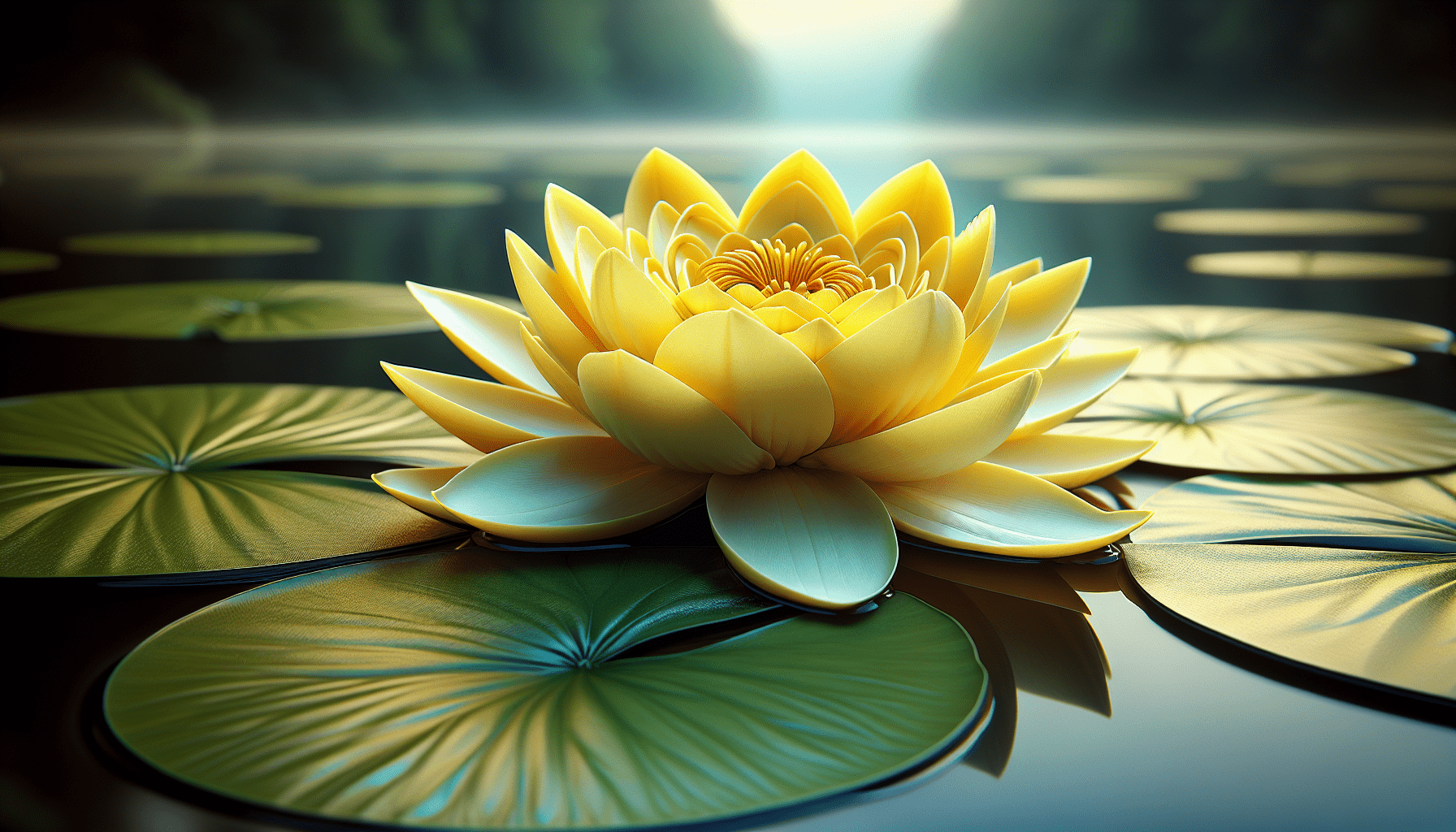Delving into the world of botany, you might encounter an aquatic plant known as the Yellow Water Lily. Laden with ornate yellow blooms, this graceful aquatic marvel typically floats atop calm, freshwater bodies. In your quest to understand this spectacular plant, you will uncover the distinctive roles Yellow Water Lilies play in their ecosystem: from their utility as a wildlife habitat to their reputation as a reliable indicator of water quality. Gain insights into this unique species, its life cycle, and its applications in various fields.

General description of Yellow Water Lily
The Yellow Water Lily, often recognized by its scientific name, Nuphar lutea, is a perennial aquatic plant that belongs to the Nymphaeaceae family. Distinguished for its beautiful floating flowers and broad, heart-shaped leaves, this plant graces many ponds and bodies of still or slow-moving water with its mesmerizing presence.
Visual appearance of the plant
The Yellow Water Lily boasts vibrant yellow, cup-shaped flowers that sit atop sturdy stalks, floating delicately on the water’s surface. Each flower, typically measuring up to 6cm across, consists of several sepals and smaller, inner petal-like stamens. Underneath the quiet dance of the flowers, the submerged part of the plant features large, round or heart-shaped leaves with a glossy green, sometimes leathery surface.
Scientific classification
Belonging to Kingdom Plantae, the Yellow Water Lily is grouped within the Angiosperms class, notable for their blooming flowers. Its order, Nymphaeales, brings together water-dwelling plants, while its family, Nymphaeaceae, is recognized for its wide array of water lilies. The Nuphar genus is defined by the yellow or red tint of its flowers, and the lutea species specifically refers to this Yellow Water Lily.
International names and synonyms
Internationally, the Yellow Water Lily may be known by a range of names, such as Brandy-Bottle in the United Kingdom due to its distinctive bottle-shaped flowers and strong scent. Scientific synonyms for Nuphar lutea include the likes of Nymphaea lutea and Castalia flava.
Distribution of Yellow Water Lily
Yellow Water Lilies are found dispersed across various regions, primarily in the Northern hemisphere.
Natural habitat
Their natural habitat is in bodies of still or slow-moving freshwater such as ponds, lakes, marshes, and ditches, where they can root in deep, marshy substrates while extending their leaves and flowers up to the surface.
Geographical distribution
On a geographical level, Yellow Water Lilies have been recorded throughout North America, Europe, parts of Asia, and North Africa. The Eastern United States, Canada, and the British Isles famously host large populations of this aquatic plant.
Climatic conditions it prefers
As for climate preferences, Yellow Water Lilies excel in temperate zones with sufficient rainfall and sunlight. However, they are sufficiently adaptable to manage in a variety of conditions, and certainly resilient enough to withstand harsh winters in colder climates.
Growth and life cycle of Yellow Water Lily
The Yellow Water Lily, as a perennial plant, delights with its continual cycle of growth, blooming in the summer and withdrawing back to the murky depths in winter.
Growth process
Starting as tuberous underground rhizomes, the Yellow Water Lily shoots out stem-like runners that eventually produce leaf buds. These buds then rise to the water surface while unfurling into mature leaves along the way. Around late spring to early summer, the plant starts showcasing its namesake yellow flowers, serving as a spectacle for bystanders and a feeding ground for pollinators.
Seasonal changes
As seasons bid farewell to the lush summer and welcome the stark winter, the Yellow Water Lily follows suit. Its observable parts, namely the leaves and flowers, wither away and return to the protection of the water bed, not to be seen again until the following spring. This process of detaching from the surface is often catalyzed by colder temperatures and shorter day lengths.
Life expectancy and stages
While a single yellow flower typically lives for an average of 4-5 days, the whole plant can persist for several years, repeating its captivating display each summer. From budding to blooming to retreating, the Yellow Water Lily thus circles through the stages of growth, maturity, decline, and dormancy as part of its life course.

Environmental requirements for Yellow Water Lily
Much like other aquatic plants, Yellow Water Lilies have a specific set of environmental needs, specified below.
Water requirements
Unsurprisingly for an aquatic plant, water is an essential part of the Yellow Water Lily’s living environment. The plant prefers bodies of fresh, still or slow-moving water and can accommodate depths of up to 1.5 meters.
Soil requirements
Yellow Water Lily thrives with a rich, loamy soil that its sturdy rhizome can root into, serving as both an anchor in the moving water and a storehouse of nutrients.
Light and temperature requirements
Yellow Water Lily appreciates full sun to guide its growth, though it can tolerate some partial shade. When it comes to temperature, the plant is found to be surprisingly resilient, handling cold winter conditions smoothly by entering its annual dormancy period.
Propagating Yellow Water Lily
Yellow Water Lilies can be propagated both by seeds and vegetatively, through division of their rhizomes.
Seed propagation
In the wild, seed propagation occurs when formed seeds fall into the water and sink to the bottom. However, in a specialized horticultural environment, collected seeds can be sown into pots with a soil-wet mix, then submerged and kept at warm temperatures to encourage germination.
Vegetative propagation
For a faster method, vegetative propagation can be carried out by carefully dividing the rhizomes, ensuring each section carries at least one bud. They are then replanted, with the bud exposed to light, in a container of rich, water-retaining soil.
Optimum conditions for propagation
Regardless of propagation method, for a successful process, Yellow Water Lily requires a symbiotic environment. This translates into the provision of ample light, a consistent temperature range, and a nutrient-rich substrate that holds enough water.
Caring for Yellow Water Lily
Care for the Yellow Water Lily is required mainly through fertilization, pruning, and pest management strategies.
Fertilizer needs
In a pond setting, the Yellow Water Lily’s nutrient demands are mostly met by the natural processes occurring in the water and the soil substrates. However, for container-grown plants, they can benefit from an application of slow-release aquatic plant fertilizer during the peak growth period in spring and early summer.
Pruning and maintenance
Pruning involves removing any withered leaves or flowers to prevent them decaying in the water, thus maintaining the visual appeal and the overall health of the plant.
Managing pests and diseases
While generally resistant to most diseases and pests, Yellow Water Lilies can sometimes attract aphids. In such cases, biological controls may be utilized, such as introducing predator species to the pond environment.
Benefits and uses of Yellow Water Lily
Yellow Water Lily presents several uses and benefits.
Ornamental use
From an aesthetic standpoint, Yellow Water Lily adds significant charm to backyard ponds, lakes, or water features with its vibrant yellow flowers and characteristic round leaves.
Culinary use
A lesser-known benefit of the Yellow Water Lily is its potential culinary use. Its young leaves, buds, and fruits can be cooked and eaten, while its seeds can be ground to use as flour.
Medicinal use
In traditional medicine practices, parts of the Yellow Water Lily have been used for their antiseptic, anodyne, and sedative properties.
Religious and cultural significance
Historically, Yellow Water Lily was depicted often in medieval monastery gardens and considered symbolic in religious contexts for its transformation from submerged plant to a flower reaching for the sky.
Challenges in growing Yellow Water Lily
Growing Yellow Water Lily can present a few challenges, related primarily to diseases, pests, and growing conditions.
Common diseases and pests
Aphids, as aforementioned, can trouble the lily by feeding on its sap. Also, if the water it inhabits becomes too polluted or murky, this can hinder its growth.
Environmental threats
As with all flora, Yellow Water Lily is susceptible to unfavorable changes in its environment. Prolonged droughts, pollution, and habitat destruction pose significant threats.
Difficulty in propagation
Propagation of Yellow Water Lily, especially by seed, can be somewhat challenging for those lacking horticultural experience. Seeds can take a long time to germinate and require specific conditions to do so successfully.
Conservation status of Yellow Water Lily
Thankfully, Yellow Water Lily is currently not considered a threatened species.
Current conservation status
According to the International Union for Conservation of Nature (IUCN), Yellow Water Lily is classified as of ‘Least Concern’ on their Red List of Threatened Species.
Threats facing the species
While not significantly threatened, potential risks, when considered cumulatively, include loss of wetland habitats, climate change, and pollution.
Efforts to conserve the Yellow Water Lily
Different bodies, collectively and individually, are conducting rigorous efforts to conserve wetlands, monitor plant populations, and educate the public about the importance of biodiversity, including species like Yellow Water Lily.
Fun facts about the Yellow Water Lily
Apart from their uses, Yellow Water Lilies intrigue us with several fun features.
Interesting biological traits
These include their adaptation to a fully-submerged life, their uniquely shaped flowers, self-fertilization, and their dormant seeds that can survive, ready to germinate up to several years later.
Cultural references
Culturally, water lilies are often symbolized in art and literature. In Christian iconography, they sometimes represent purity and chastity.
Trivia associated with this aquatic plant
An interesting piece of trivia is that despite their name, Yellow Water Lilies are actually not true lilies. They belong, as discussed earlier, to the water lily family, Nymphaeaceae.
The Yellow Water Lily painting by Charles Courtney Curran, a renowned American painter, is also worth mentioning due to the illustration’s overflow of the luminous yellow blossoms.
In conclusion, Yellow Water Lilies, with their beauty, utility, and intriguing nature, serve as a valuable addition to aquatic environments around the world, uplifting the landscapes and enriching the biosphere.
